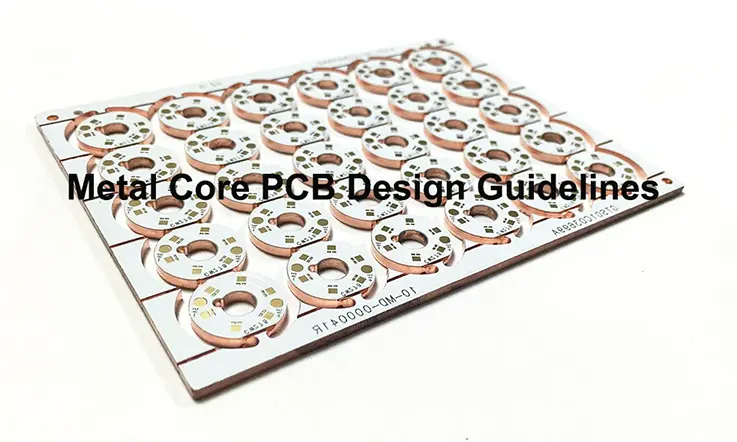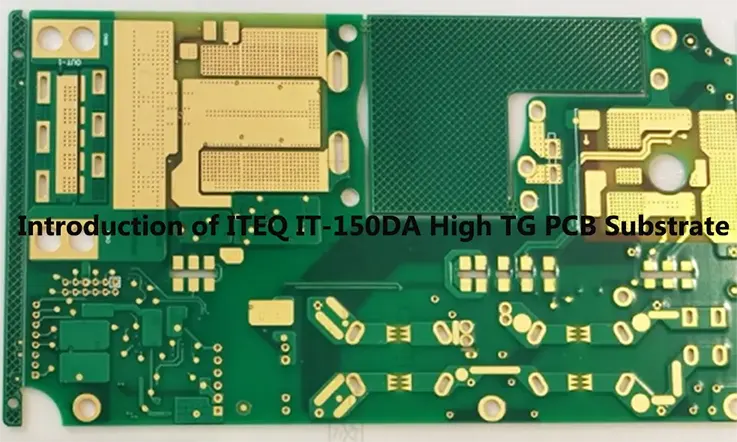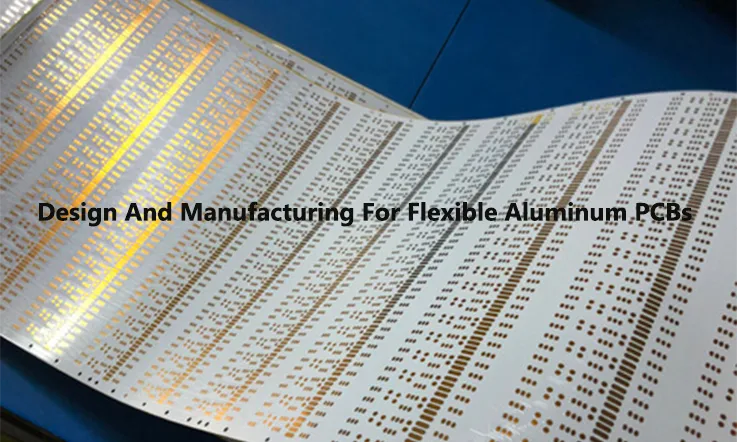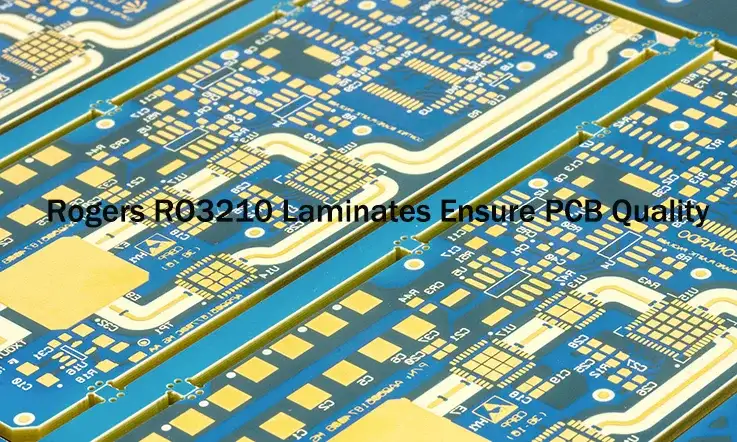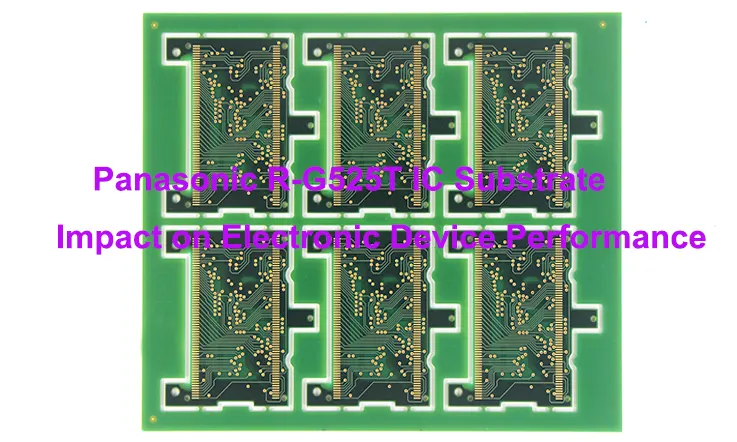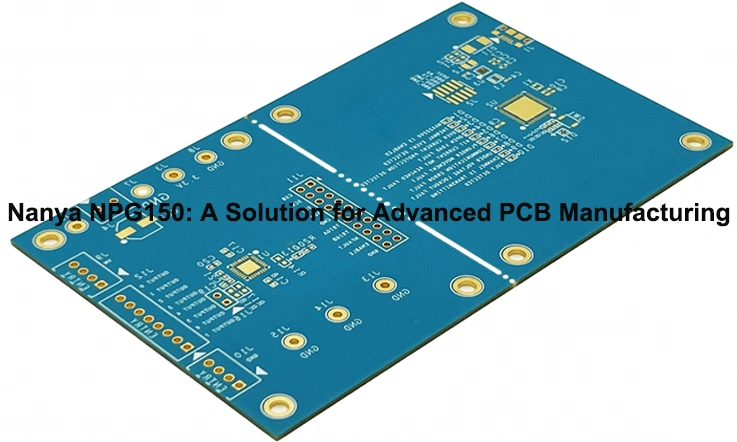
In the highly competitive world of electronics manufacturing, selecting the right printed circuit board (PCB) material is crucial for ensuring optimal performance, reliability, and cost-effectiveness. Among the wide array of options available, Nanya NPG150 PCB material stands out as a comprehensive solution that addresses the demanding requirements of modern electronic devices. With its exceptional electrical performance, thermal management capabilities, mechanical strength, and compatibility with manufacturing processes, Nanya NPG150 offers electronic manufacturers a compelling choice for their high-performance applications.
Key Features of NanYa NPG150
Nanya NPG150 is a high-performance thermoset epoxy laminate designed specifically for use in printed circuit boards (PCBs). It is commonly used in applications that require excellent electrical performance, thermal management, and mechanical strength. Here are some key features and characteristics associated with Nanya NPG150 PCB material:
1. High thermal conductivity: NanYa NPG150 has a thermal conductivity of 1.5 W/m·K, which allows for efficient heat transfer and dissipation.
2. Excellent electrical insulation: The material has excellent electrical insulation properties, making it suitable for applications where electrical conductivity needs to be minimized.
3. Flame retardancy: NanYa NPG150 is flame retardant, ensuring safety in applications where fire resistance is crucial.
4. Good mechanical strength: The material has good mechanical strength, allowing it to withstand various stresses and strains.
5. Chemical resistance: NPG150 is resistant to a wide range of chemicals, making it suitable for use in harsh environments.
6. Low water absorption: The material has low water absorption, reducing the risk of degradation due to moisture.
7. Easy processing: NanYa NPG150 can be easily processed using common manufacturing techniques such as injection molding and extrusion.
8. Wide temperature range: The material can operate in a wide temperature range, from -40°C to 150°C, making it suitable for a variety of applications.
9. RoHS compliant: NanYa NPG150 is compliant with the Restriction of Hazardous Substances (RoHS) directive, ensuring it meets strict environmental standards.
10. Versatile applications: Due to its excellent properties, NanYa NPG150 is used in various industries and applications, including electronics, automotive, aerospace, and telecommunications.
Nanya NPG150 Comparison with Other PCB Materials
When comparing Nanya NPG150 with other PCB materials, it’s important to consider various factors such as electrical performance, thermal management, mechanical strength, processability, cost, and specific application requirements. Here’s a general comparison of Nanya NPG150 with some commonly used PCB materials:
1. FR-4: FR-4 is a widely used standard PCB material. Compared to FR-4, Nanya NPG150 may offer better electrical performance, including lower dielectric constant (Dk) and loss tangent (Df), resulting in improved signal integrity and reduced signal loss at high frequencies. Nanya NPG150 may also have better thermal conductivity and mechanical strength, making it more suitable for applications that require efficient heat dissipation and robustness. However, Nanya NPG150 may be relatively more expensive than FR-4.
2. High-Tg FR-4: High-Tg FR-4 is a variant of FR-4 with a higher glass transition temperature. In comparison, Nanya NPG150 may provide similar or better electrical performance, thermal management, and mechanical strength, depending on the specific requirements. High-Tg FR-4 may be more cost-effective for applications that do not require the enhanced properties offered by Nanya NPG150.
3. PTFE (Polytetrafluoroethylene): PTFE-based PCB materials, such as Rogers RO4000 series, are known for their excellent electrical performance, including low Dk and Df, as well as high-frequency capabilities. They also offer good thermal stability. In comparison, Nanya NPG150 may have lower dielectric performance but can provide better thermal management and mechanical strength. PTFE-based materials tend to be more expensive and may require specialized fabrication processes.
4. Metal Core PCBs: Metal Core PCBs, such as Aluminum-based or Copper-based boards, are used for applications that require efficient heat dissipation. In terms of thermal management, metal core PCBs generally outperform Nanya NPG150 due to the direct heat-spreading capabilities of the metal core. However, Nanya NPG150 may offer better electrical performance and mechanical strength. Metal core PCBs are typically more expensive and require specific design considerations.
5. Ceramic PCBs: Ceramic PCBs, made of materials like aluminum oxide (Al2O3) or aluminum nitride (AlN), offer excellent thermal conductivity and electrical insulation properties. They are highly suitable for high-power and high-temperature applications. Compared to ceramic PCBs, Nanya NPG150 may have lower thermal conductivity but can provide better electrical performance and mechanical strength. Ceramic PCBs are usually more expensive and require specialized manufacturing processes.
It’s important to note that the suitability of a particular PCB material depends on the specific application requirements, such as frequency range, power dissipation, size constraints, cost considerations, and environmental conditions. Conducting a thorough evaluation of these factors, along with material specifications and performance data, is crucial for selecting the most appropriate PCB material for a given application. Consulting with PCB material manufacturers and considering their application guidelines can also provide valuable insights for the selection process.
What Factor Consideration When Performance Comparison with Other PCB Materials?
When comparing the performance of Nanya NPG150 PCB material with other PCB materials, several factors should be considered. Here are some key aspects to compare:
1. Electrical Performance:
Dielectric constant (Dk): Compare the relative permittivity of Nanya NPG150 with other materials to assess its impact on signal integrity and impedance control.
Loss tangent (Df): Evaluate the dissipation factor to determine the material’s ability to minimize signal loss and maintain high-frequency performance.
Electrical insulation: Compare the breakdown voltage and insulation resistance of Nanya NPG150 with other materials to ensure proper electrical isolation.
2. Thermal Performance:
Thermal conductivity: Compare the thermal conductivity of Nanya NPG150 with other materials to assess its ability to dissipate heat effectively, particularly in high-power applications.
Coefficient of thermal expansion (CTE): Evaluate the CTE to understand the material’s dimensional stability under temperature variations and its compatibility with other components.
Tg (Glass Transition Temperature): Compare the Tg of Nanya NPG150 with other materials to determine its ability to withstand elevated temperatures during assembly and operation.
3. Mechanical Properties:
Flexural strength: Compare the material’s resistance to bending or flexing to assess its mechanical robustness and reliability.
Tensile strength: Evaluate the material’s ability to withstand pulling forces without deformation or breakage.
Impact resistance: Compare the material’s resistance to mechanical shocks or impacts to ensure the durability of the PCB.
4. Processability:
PCB fabrication techniques: Compare the ease of processing and compatibility of Nanya NPG150 with various fabrication techniques, such as drilling, etching, plating, and soldering.
Handling and manufacturability: Assess the material’s ease of handling during assembly and its compatibility with standard PCB manufacturing processes.
5. Environmental Considerations:
RoHS compliance: Verify the material’s compliance with RoHS (Restriction of Hazardous Substances) regulations to ensure its environmental friendliness.
Sustainability: Consider the recyclability and environmental impact of Nanya NPG150 compared to other materials.
6. Cost:
Material cost: Compare the cost of Nanya NPG150 with other PCB materials to evaluate its cost-effectiveness for the specific application.
PCB Fabrication Techniques with Nanya NPG150
When working with Nanya NPG150 PCB material, there are several fabrication techniques commonly used in the industry. Here are some PCB fabrication techniques that may be applicable to Nanya NPG150:
Substrate Preparation:
Cleaning and surface treatment: Proper cleaning and surface preparation of the substrate are essential for optimal bonding and adhesion of Nanya NPG150 material.
Material Selection:
Base material selection: Choose Nanya NPG150 as the base material for the PCB, considering its specific electrical, thermal, and mechanical properties.
Layer Stackup Design:
Design considerations: Determine the number of layers, copper thickness, and dielectric thickness based on the PCB requirements and Nanya NPG150 material properties.
Signal and power plane allocation: Plan the allocation of signal and power planes within the layer stackup to ensure proper signal integrity and power distribution.
Circuit Design and Layout:
PCB design guidelines: Follow the recommended design guidelines provided by Nanya for using NPG150 material, including minimum trace widths, spacing, and via requirements.
Thermal considerations: Consider the thermal characteristics of Nanya NPG150 during component placement and routing to ensure effective heat dissipation.
Photolithography:
Photoresist application: Apply photoresist material onto the Nanya NPG150 substrate, following standard photolithography processes.
Mask alignment and exposure: Align the photomask accurately and expose the photoresist to UV light, transferring the circuit pattern onto the substrate.
Etching:
Chemical etching: Use appropriate etchants to remove unwanted copper from the substrate, leaving behind the desired circuit traces.
Etch resist stripping: Remove the photoresist material after etching is complete, leaving clean copper traces on the Nanya NPG150 substrate.
Plating:
Copper plating: Electroplate additional copper onto the circuit traces to increase their thickness and ensure conductivity.
Surface finishing: Apply surface finishes such as HASL (Hot Air Solder Leveling), ENIG (Electroless Nickel Immersion Gold), or OSP (Organic Solderability Preservatives) to protect the copper and facilitate soldering.
Drilling and Vias:
Mechanical drilling: Use drills to create holes for component mounting and interconnection.
Via formation: Plate the drilled holes with conductive material to create vias for electrical connections between different PCB layers.
Soldermask and Legend Printing:
Soldermask application: Apply a soldermask layer to protect the circuitry and provide insulation between copper traces.
Legend printing: Print component designators, logos, and other markings on the PCB surface for identification.
Final Inspection and Testing:
Electrical testing: Conduct various electrical tests, such as continuity testing and impedance measurements, to ensure the functionality and integrity of the fabricated PCB.
Visual inspection: Perform a thorough visual inspection to check for any defects or manufacturing issues.
Which Industry Main Application of Nanya NPG150?
Nanya NPG150, as a high-performance PCB material, finds application in various industries that require reliable and high-quality printed circuit boards. While the specific applications may vary, here are some industries where Nanya NPG150 can be commonly utilized:
1. Telecommunications.
2. Aerospace and Defense.
3. Automotive.
4. Industrial Automation.
5. Medical Devices.
6. Consumer Electronics.
It’s important to note that the application of Nanya NPG150 is not limited to these industries, and it can be utilized in other sectors where high-performance PCBs are required. The specific application within each industry may depend on the performance requirements, environmental conditions, and other factors unique to that particular application.
Conclusion
As electronic manufacturers strive to meet the ever-increasing demands of performance, reliability, and cost optimization, the choice of PCB material plays a critical role. Nanya NPG150 emerges as an exceptional solution that caters to the needs of advanced electronics manufacturing. Its outstanding electrical performance, thermal management capabilities, mechanical strength, and compatibility with manufacturing processes make it a preferred choice for high-performance applications in industries such as telecommunications, aerospace, automotive, industrial automation, medical devices, and consumer electronics.
By selecting Nanya NPG150, electronic manufacturers gain a competitive edge by ensuring signal integrity, efficient heat dissipation, mechanical robustness, and reliable production processes. The high-quality standards and rigorous testing procedures associated with Nanya NPG150 provide manufacturers with the confidence to deliver exceptional products to their customers.

